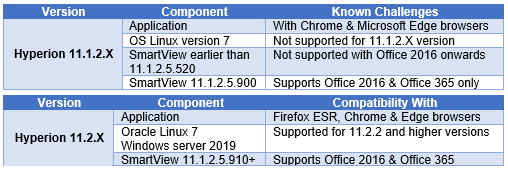Many organizations that have implemented Oracle Hyperion version 11.1.X may be aware that some (or many) of their Hyperion application components will need to be upgraded by the end of 2021. In this blog, we summarize the Hyperion components for which Oracle will reduce support, a change which may assist organizations in prioritizing their short-term technology initiatives.
Which Hyperion Components will Undergo Changes?
Organizations running Hyperion applications of the 11.1.X version variety (e.g., Hyperion Planning/HP, Hyperion Financial Management/HFM, Tax Reporting, etc.), will no longer be offered premier support from Oracle after December 2021. Although Oracle will continue to provide extended and sustaining support, continued degradation of compatibilities, like those listed below, may become more prevalent.
(An overview of the various support models provided by Oracle can be found here. The premier support, extended support and sustaining support models for EPM are the same as for EBS.)

What Does this Mean for Organizations Currently Running Hyperion 11.1.X?
In a nutshell, it means that any of the existing applications on 11.1.X will no longer receive product enhancements or updates to the delivered/existing features and functionalities after 2021. Over time, this could lead to performance issues, reliability risks or other complications (like server memory max-out, unresponsive application/OS, SSL3 or browser incompatibility, increased consolidation cycle time, non-compliance to audit requirements etc.), which would be the onus of internal IT departments to resolve. End users could also experience incompatibility issues with future MS Office versions.
What Options do Organizations Have?
The short answer to this is to either upgrade to Hyperion 11.2.X – an on-premise offering – or move to Enterprise Performance Management (EPM), Oracle’s next-gen, cloud-based version of Hyperion.
- Upgrading to Hyperion 11.2.X can be a good option for organizations that are already on 11.1.2.4, need to retain their customizations and can afford the large associated investment (i.e., hosting/hardware, administration, security). This path assumes organizations will:
- Apply outstanding updates/patches for 11.1.2.4,
- Size their hardware sufficiently to meet Oracle’s 11.2.X recommendations, and
- Perform a full installation of Hyperion 11.2.X and migrate to preserve all historical metadata and associated artifacts.
For organizations on versions earlier than 11.1.2.4, additional factors must be considered as the upgrade path to 11.2.X becomes more time consuming and iterative (e.g., customers on 11.1.2.2 need to upgrade/apply Release Update Packages/RUP to version 11.1.2.4 and then migrate to 11.2.X).
- Moving to EPM Cloud is a viable option for all organizations, irrespective of whether or not they are already adopting a cloud strategy.
Should Organizations Move to EPM Cloud?
Most for-profit organizations typically have growth goals (e.g., revenue, operating income, share price, etc.) and as a result, are leveraging any available data points to achieve it. An on-premise application inevitably places additional burden on internal practices dedicated to maintaining organizational data and also increases the cost of storing, handling, securing and processing sensitive data. Oracle’s EPM product shifts this specific burden to a trusted third-party, while still allowing an organization to manage the application, own their data and control user administration.
If organizations decide to wait for their existing Hyperion applications to meet their support sunset dates, rather than proactively migrate to the Cloud, additional costs of ownership come into play. Not only will they need to maintain the application and its infrastructure, but they will also require resources with requisite skillsets which, over time, will become increasingly scarce.
Before assuming that an upgrade to Hyperion 11.2.X is the most rational option, consider these questions:
- How familiar is the organization with EPM Cloud solution offerings and their capabilities?
- Does Hyperion on-premise really fit an organization’s technology roadmap and scalability needs?
- What are the hurdles currently stopping organizations from moving to Cloud?
- Using a three-year timeline, what are an organization’s cost savings (IT infrastructure, overhead, etc.) realized by moving to cloud?
Conclusion
Based on Oracle’s Hyperion roadmap (referenced here from Oracle Open World 2019), the shift to cloud appears imminent; therefore, organizations that currently utilize Hyperion should consider transitioning to EPM. It provides pre-configured features, rules and artifacts that are on par with its on-premise predecessor and exceeds historical scaling capabilities to handle organizational complexities and large user/data volumes. Even though the Software-as-a-Service (SAAS) model limits the ability to customize the product, this is typically offset by Oracle’s commitment to constantly improve EPM capabilities (i.e., new features rolled out quarterly). Additionally, Oracle’s updated licensing models and attractive discounts make it financially feasible for organizations of all sizes.
Protiviti’s Oracle team is uniquely positioned to help organizations think through the next steps, whether it be maintaining on-premise systems or transitioning to cloud offerings. To learn more about how Protiviti can help with Oracle, please visit our Oracle Solutions site or contact us.



